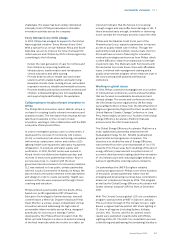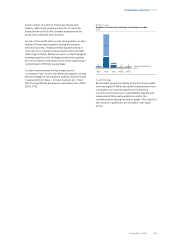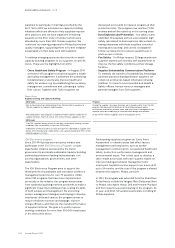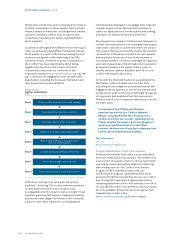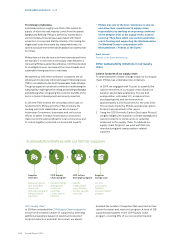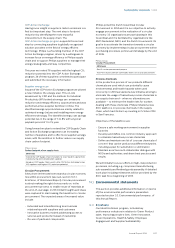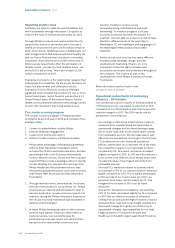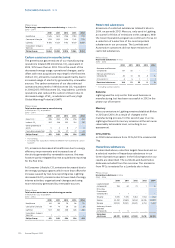Philips 2014 Annual Report Download - page 202
Download and view the complete annual report
Please find page 202 of the 2014 Philips annual report below. You can navigate through the pages in the report by either clicking on the pages listed below, or by using the keyword search tool below to find specific information within the annual report.
Sustainability statements 14.2.8
202 Annual Report 2014
suppliers to participate in trainings provided by the
EICC. Since 2012 we extended our capacity building
initiatives which are oered to help suppliers improve
their practices, and we have organized 24 training
sessions on the EICC Code of Conduct which were
attended by more than 500 Chinese suppliers. We
continued our training programs for Philips buyers and
quality managers, supporting them to further integrate
sustainability in their daily work with suppliers.
To address emerging issues we also provide in-depth
capacity building programs to our suppliers on specic
topics. These are the highlights from 2014:
•China Health and Safety Program - In August 2014
we kicked-o a program to improve supplier’s health
and safety management. It addresses the underlying
fundamentals to structurally improve health and
safety for workers, e.g. by establishing the necessary
management commitment and cultivating a ‘safety
rst’ culture. Together with 7 pilot suppliers we
developed scorecards to measure progress at their
production sites. The program now reaches 7,000
workers and will be scaled up in the coming years.
•Dust Explosion and Prevention - Our safety scans
identied 30 suppliers with an unacceptable high
safety risk related to dust explosion. We worked on
raising awareness with these suppliers, provided
training and coaching, and carried out targeted
follow-up inspections to ensure suppliers put in
place proper controls.
•Fire Safety - On Philips request, 20 large warehouse
suppliers started with monthly self-assessments to
improve the re safety conditions at their storage
facilities.
•Supplier Sustainability Communication Platform -
To intensify the transfer of sustainability knowledge
and best practices sharing between suppliers, we
rolled out an Internet-based information sharing
platform. It connects environmental and Health &
Safety ocers, human resource managers and
general managers from 500 suppliers.
Philips Group
Supplier training and capacity building
2014 Goals Progress
Roll-out best practices and learnings from IDH electronics program to
Chinese suppliers included in audit program
During the supplier classroom trainings we included insights from the IDH
program. We paid special attention to the relation between worker
satisfaction and worker turnover rates, and how factory management can
improve these by establishing a communication bridge with workers
Start dedicated 3-year program to improve Health & Safety conditions in
supplier factories. Start roll-out to 20% of the Chinese suppliers in 2014
57 out of 410 Chinese suppliers now in the program (14%)
2015 Goals
Train 150 suppliers during at least 8 two-day sustainability training sessions
to address top sustainability issues from 2014 audits
Implement corrective actions to close all major NCs identied at supplier sites
during 2014. Provide tailor made and on-site capacity building for 90% of the
related suppliers in China
IDH Electronics program
Since 2011 Philips has been an active initiator and
participant in the IDH Electronics Program, a multi-
stakeholder initiative sponsored by the Dutch
government to accelerate sustainable trade by building
partnerships between leading multinationals, civil
society organizations, governments, and other
stakeholders.
The IDH Electronics Program aims to support the
development of sustainable and innovative workforce
management practices for over 75 suppliers. Unlike
other CSR programs that have been implemented
previously in the industry, this program steers away
from traditional auditing methods and seeks to make a
signicant impact by building and up-scaling the skills
of both workers and management. By promoting
worker-management dialogue and helping to develop
employees’ skills and careers, the program strives to
reduce employee turnover and wastage, improve
energy eciency and improve the overall performance
of supplier factories. The goal is to jointly improve
working conditions for more than 500,000 employees
in the electronics sector.
Participating suppliers are given an ‘Entry Point
Assessment’ to identify issues that aect factory
management and employees, such as worker-
management communication, occupational health and
safety, production, performance management and
environmental issues. This is then used to develop a
tailor-made action plan with each supplier, based on
improved dialogue between management and
employees. Suppliers receive support over a period of
up to 24 months, and the cost of the program is shared
between the supplier, Philips, and IDH.
In 2013, the program was extended from the Pearl River
Delta Area to include the Yangtze River Delta area. Next
to Philips, also Apple, Nokia, Dell and Hewlett-Packard
and their suppliers are participating in the program. As
of year-end 2014, 54 suppliers participate including 21
Philips suppliers.







